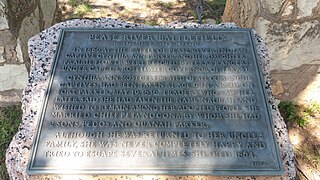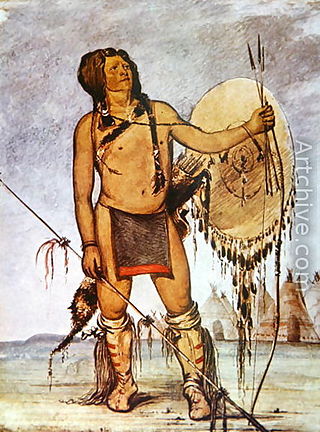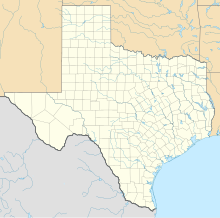
Peta Nocona, also known as Puhtocnocony, or Tah-con-ne-ah-pe-ah, the son of Puhihwikwasu'u, or Iron Jacket, was a chief of the Comanche Quahadi band. He married Cynthia Ann Parker, who had been taken as a captive in a raid and was adopted into the tribe by Tabby-nocca's family. Among their children was Quanah Parker, the last war chief of the Comanche.

The Comanche Wars were a series of armed conflicts fought between Comanche peoples and Spanish, Mexican, and American militaries and civilians in the United States and Mexico from as early as 1706 until at least the mid-1870s. The Comanche were the Native American inhabitants of a large area known as Comancheria, which stretched across much of the southern Great Plains from Colorado and Kansas in the north through Oklahoma, Texas, and eastern New Mexico and into the Mexican state of Chihuahua in the south. For more than 150 years, the Comanche were the dominant native tribe in the region, known as “the Lords of the Southern Plains”, though they also shared parts of Comancheria with the Wichita, Kiowa, and Kiowa Apache and, after 1840, the southern Cheyenne and Arapaho.

The Red River War was a military campaign launched by the United States Army in 1874 to displace the Comanche, Kiowa, Southern Cheyenne, and Arapaho tribes from the Southern Plains, and forcibly relocate the tribes to reservations in Indian Territory. The war had several army columns crisscross the Texas Panhandle in an effort to locate, harass, and capture nomadic Native American bands. Most of the engagements were small skirmishes with few casualties on either side. The war wound down over the last few months of 1874, as fewer and fewer Indian bands had the strength and supplies to remain in the field. Though the last significantly sized group did not surrender until mid-1875, the war marked the end of free-roaming Indian populations on the southern Great Plains.
Felix Huston (1800–1857) was a lawyer, soldier, military opportunist and the first commanding general of the Army of the Republic of Texas under the Constitution of 1836.

Comanche history is the story of the Native American (Indian) tribe which lived on the Great Plains of the present-day United States. In the 17th century the Eastern Shoshone people who became known as the Comanche migrated southward from Wyoming. In the 18th and 19th centuries the Comanche became the dominant tribe on the southern Great Plains. The Comanche are often characterized as "Lords of the Plains." They presided over a large area called Comancheria which they shared with allied tribes, the Kiowa, Kiowa-Apache, Wichita, and after 1840 the southern Cheyenne and Arapaho. Comanche power and their substantial wealth depended on horses, trading, and raiding. Adroit diplomacy was also a factor in maintaining their dominance and fending off enemies for more than a century. They subsisted on the bison herds of the Plains which they hunted for food and skins.

The Antelope Hills expedition was a campaign from January to May 1858 by the Texas Rangers and members of other allied Native American tribes against Comanche and Kiowa villages in the Comancheria. It began in western Texas and ended in a series of fights with the Comanche tribe on May 12, 1858, at a place called Antelope Hills by Little Robe Creek, a tributary of the Canadian River in what is now Oklahoma. The hills are also called the "South Canadians", as they surround the Canadian River. The fighting on May 12, 1858, is often called the Battle of Little Robe Creek.
Buffalo Hump was a War Chief of the Penateka band of the Comanches. He came to prominence after the Council House Fight when he led the Comanches on the Great Raid of 1840.

The Great Raid of 1840 was the largest raid ever mounted by Native Americans on white cities in what is now the United States. It followed the Council House Fight, in which Republic of Texas officials attempted to capture and take prisoner 33 Comanche chiefs who had come to negotiate a peace treaty, killing them together with two dozen of their family and followers. The Comanche tribe was supposed to have brought white hostages as their part of the negotiations but brought only one young woman. Arguments and fighting then broke out among the Texans and Comanches. The Texas Officials were determined to force the Comanche to release all white captives among them. To avenge what the Comanche viewed as a bitter betrayal by the Texans, the Comanche war chief Buffalo Hump raised a huge war party of many of the bands of the Comanche, and raided deep into white-settled areas of Southeast Texas.

The Council House Fight, often referred to as the Council House Massacre, was a fight between soldiers and officials of the Republic of Texas and a delegation of Comanche chiefs during a peace conference in San Antonio on March 19, 1840. The meeting took place under an observed truce with the purpose of negotiating the exchange of captives and ultimately facilitating peace after two years of war. The Comanches sought to obtain recognition of the boundaries of the Comancheria, their homeland, while the Texians wanted the release of Texian and Mexican citizens held prisoner by the Comanches.

The Battle of Little Robe Creek, also known as the Battle of Antelope Hills and the Battle of the South Canadian, took place on May 12, 1858. It was a series of three distinct encounters that took place on a single day, between the Comanches, with Texas Rangers, militia, and allied Tonkawas attacking them. It was undertaken against the laws of the United States at the time, which strictly forbade such an incursion into the Indian Territories of Oklahoma, and marked a significant escalation of the Indian Wars. It also marked the first time American or Texas Ranger forces had penetrated the Comancheria as far as the Wichita Mountains and Canadian River, and it marked a decisive defeat for the Comanches.
The Texas–Indian wars were a series of conflicts between settlers in Texas and the Southern Plains Indians during the 19th-century. Conflict between the Plains Indians and the Spanish began before other European and Anglo-American settlers were encouraged—first by Spain and then by the newly Independent Mexican government—to colonize Texas in order to provide a protective-settlement buffer in Texas between the Plains Indians and the rest of Mexico. As a consequence, conflict between Anglo-American settlers and Plains Indians occurred during the Texas colonial period as part of Mexico. The conflicts continued after Texas secured its independence from Mexico in 1836 and did not end until 30 years after Texas became a state of the United States, when in 1875 the last free band of Plains Indians, the Comanches led by Quahadi warrior Quanah Parker, surrendered and moved to the Fort Sill reservation in Oklahoma.
Santa Anna was a Native American war chief of the Penateka tribe of the Comanche Indians.
Plácido was major Native American Chief of the Tonkawa Indians in Texas during the Spanish and Mexican rule, the Republic of Texas era, and with Texas as part of the United States.
Iron Jacket (Puhihwikwasu'u) was a Native American War Chief and Chief of the Comanche Indians.
The Battle of Bandera Pass in 1841 marked the turning point of the Texas-Indian wars. Though they would continue another 34 years, the tide began to turn at Bandera Pass.

Tosahwi, meaning White Knife, was a Penateka Comanche chief. He was deemed "cooperative" by William Babcock Hazen.
Carne Muerto (Tehcap) (1832—1860s) was a Native American War Chief of the Quahadi band of the Comanche Indians.
Linnville, Texas was a town in the Republic of Texas, in what is now Calhoun County. It was founded in 1831 and destroyed in the Great Raid of 1840.

Lockhart State Park is a state park located at the southwestern edge of Lockhart, Texas, United States and is administered by the Texas Parks and Wildlife Department. The park was constructed by Civilian Conservation Corps (CCC) Company 3803 between 1935 and 1938. The park officially became a state park in 1948.
Yellow Wolf, Spirit Talker 's nephew and Buffalo Hump 's cousin and best support, was a War Chief of the Penateka division of the Comanche Indians. He came to prominence after the Council House Fight, when Buffalo Hump called the Comanches and, along with Yellow Wolf and Santa Anna, led them in the Great Raid of 1840.










